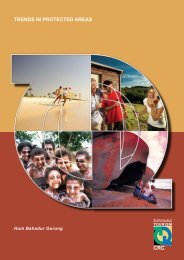icolls - Sustainable Tourism CRC
icolls - Sustainable Tourism CRC
icolls - Sustainable Tourism CRC
Create successful ePaper yourself
Turn your PDF publications into a flip-book with our unique Google optimized e-Paper software.
ECOLOGY, THREATS AND MANAGEMENT OPTIONS FOR SMALL ESTUARIES AND ICOLLS<br />
open/closed estuaries’ (Froneman 2002; Perissinotto, Nozais, Kibirige & Anandraj 2003; Teske & Wooldridge<br />
2003) in South Africa. This diverse range of names reflects the complexity and uncertainty surrounding ICOLL<br />
form and connection to the sea.<br />
We propose that the term ICOLLs best describes many of the intermittently opening systems in Australia, as<br />
they behave more like large lakes during times of closure than they do as estuaries. However, we acknowledge<br />
that systems within this subset of waterbodies may, at least seasonally or occasionally, behave like estuaries.<br />
Although many researchers consider ICOLLs to be a subset of estuaries (e.g. Day 1981; Roy et al. 2001),<br />
ICOLLs differ from estuaries in that they do not always experience the tidal ranges and salinity gradients typical<br />
of the large macrotidal rivers upon which much of our understanding of estuaries is based (Neira & Potter 1992,<br />
Balls, Macdonald, Pugh & Edwards 1995; Young, Potter, Hyndes & de Lestang 1997). In addition to these<br />
periods of reduced tidal flux, ICOLLs tend to have comparatively low surface and catchment areas. In Australia,<br />
freshwater discharge into ICOLLs is generally low and, subsequently, their connection to the sea is usually<br />
infrequent (Young et al. 1997; Roy et al. 2001). Thus for extended periods they may function more like saline<br />
lakes, but with unique biogeochemical characteristics and limnological processes.<br />
The role of ICOLLs in coastal zone conservation and fisheries production has long been overshadowed by<br />
the high productivity and fisheries catches that typify large estuaries (Pease 1999; Roy et al. 2001; Saintilan<br />
2004). Nevertheless, ICOLLs provide nursery and breeding habitats for a wide range of commercially and<br />
recreationally valuable fish, mollusc and crustacean species (Pollard 1994b; Bell 1997; Roy et al. 2001). In<br />
addition, ICOLLs can provide habitat and resources to rare and threatened species that do not occur in large<br />
macrotidal estuaries (Arthington & Marshall 1999; Hughes, Ponniah, Hurwood, Chenoweth & Arthington 1999;<br />
Bilton, Paula & Bishop 2002; Watts & Johnson 2004).<br />
Although water quality changes and fisheries production responses to changes in catchment management<br />
practices are reasonably well understood in large estuaries (Edgar & Barrett 2000; Josefson & Rasmussen 2000;<br />
Bowen & Valiela 2001; Morrisey, Turner, Mills, Williamson & Wise 2003), the response of ICOLLs to natural<br />
and artificial (human) perturbations are largely unknown. We believe that whilst much of the literature on<br />
estuaries is likely to be useful in the conceptualisation of ICOLL ecological processes, only dedicated research in<br />
these systems will ensure that their unique characteristics are understood, and consequently, coastal conservation<br />
and fisheries production goals met in the future. In light of increasing developmental pressures in coastal regions<br />
of Australia and the absence of reliable ecological information on ICOLLs, the identification of key knowledge<br />
gaps is essential to prioritise research that will enable ecologically sustainable management of these systems<br />
(Blaber et al. 2000; Jones, Tyler & Wither 2002; Wilson 2002). We identify high priority research themes in this<br />
Chapter.<br />
At present, the major processes threatening the ecological health of coastal waterways (including ICOLLs)<br />
are (see Table 1):<br />
• Eutrophication and contamination – excessive nutrient and contaminant inputs from agricultural,<br />
industrial and urban sources;<br />
• Fisheries – impacts of excessive harvesting of fish and macroinvertebrates by commercial and<br />
recreational fishers;<br />
• Modification of flow regimes, including water allocation to industry, urban settlements and agriculture,<br />
and specifically for ICOLLs, the artificial breaching of berms;<br />
• <strong>Tourism</strong> – increasing tourist and resident recreational demand and use of ICOLLs; and<br />
• Coastal development – increasing land clearing for urban, industrial and agricultural land uses, and<br />
habitat loss through in-system modifications.<br />
This report presents a review of current understanding of the effects of each of the listed threatening<br />
processes, with emphasis on our knowledge or lack thereof with respect to ICOLLs. We draw heavily on<br />
estuarine data and resources from the scientific literature, but also refer to lake and river literature to aid<br />
understanding of systems that experience long periods without surface water connection to the ocean.<br />
2











